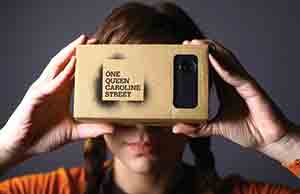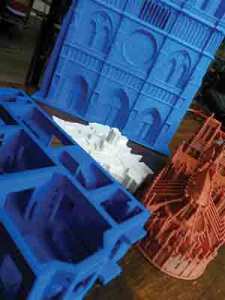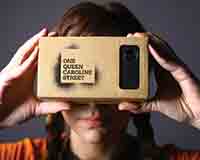London’s high-tech tomorrow is already here. Mark Simmons presents a round-up of the types of technology that are changing the way people deal with property in the capital
Start-ups
 Some of the most innovative trends that will shape future property markets are yet to be discovered. Earlier this year PiLabs, Europe’s first property-focused technology accelerator company, chose the first round of five start-ups and opened a crowdfunding campaign that has raised £600m. PiLabs, in partnership with Cushman & Waefield and Spire Ventures, will be presenting the initial cohort to potential investment partners at a demo day later this month.
Some of the most innovative trends that will shape future property markets are yet to be discovered. Earlier this year PiLabs, Europe’s first property-focused technology accelerator company, chose the first round of five start-ups and opened a crowdfunding campaign that has raised £600m. PiLabs, in partnership with Cushman & Waefield and Spire Ventures, will be presenting the initial cohort to potential investment partners at a demo day later this month.
Faisal Butt, PiLabs’s co-founder, who helped sift through the first batch of entries from more than 60 countries, was impressed by the diversity of talent. The majority of entries were based on software, though more hardware-based solutions are expected in future rounds. “At least two of the entries could revolutionise how the industry works,” says Butt.
They include Rialto, a cross-sector online property agent and landlord platform, and Wilde Rooms, a London-wide online retail aggregation service. Applications opened last month for the next wave of potential start-ups, which will be announced on 1 September. PiLabs aims to run two of these programmes each year.
Virtual reality
 Virtual reality is no longer just for gamers. As hardware prices have dropped – £99 for a high-end Oculus Rift headset or just £13 for a Google Cardboard viewer – property applications have appeared. Building managers are using them behind the scenes.
Virtual reality is no longer just for gamers. As hardware prices have dropped – £99 for a high-end Oculus Rift headset or just £13 for a Google Cardboard viewer – property applications have appeared. Building managers are using them behind the scenes.
Chris Lewis, senior director at Deloitte Real Estate, says: “Using Oculus you can mark issues that need remediation via your headset rather than physically sticking tags on the building. It’s definitely past the pioneer phase and is affordable and reliable.”
Perhaps the largest potential for the technology is in guiding prospective occupiers through a virtual building.
London-based marketing consultancy Siren chose a branded Google Viewer to focus attention on Landid’s and Brockton Capital’s stripped-down refurbishment of Coca Cola’s former HQ at 1 Queen Caroline Street, W6. “We wanted something edgy to match Landid’s profile,” says Siren director Rob Hawkins.
Joint letting agent Stuart Austin of JLL isn’t too worried that the technology will make him redundant. He says: “We use it as a supplementary tool when potential occupiers are actually in the building.”
Start-ups such as Clerkenwell-based Visual-Wise are already offering VR-based building walk-throughs using the Cardboard viewer, which works in conjunction with an Apple or Android phone. Co-founder Megan Masterson says: “Rather than going on the high-end headset route, we want to make it as accessible as possible.”
Some firms, such as Virtual Walkthrough, prefer to produce highly detailed video and still images. Founder James Morris-Manuel says: “We ensure that our images have the correct perspective, so someone can make a proper business decision.”
Building management
Howard Bottomley and Rob Riley, founders of software product Tenant Assistance Program, are no tech geeks, but certainly know their property, having worked previously for CBRE and Canary Wharf Group respectively. So they channelled that expertise into developing an online hub that aims to seamlessly draw together all the data required by tenants when occupying their buildings.
“This the last section of property that’s being digitised, and it has been difficult to provide a satisfactory user experience,” says Bottomley. The pair acknowledge that some of the largest London landlords have developed their own online services over the past decade, but insist that their tenant-orientated approach will benefit landlords and tenants alike.
Property managers may be less happy as the software could automate many of their routine functions. But Riley says: “The portal won’t necessarily make them redundant, but it is likely to re-assign their roles so they spend less time on mundane tasks and more pro-actively dealing with real people.”
3D printing
 Science fiction has become science fact when it comes to 3D printing. Home models can be bought as kits online for less than £200 and even professional models are available for under £2,000. “Property and architectural firms still view 3D as blue sky when it’s not,” says Ed Greig, disruptor at Deloitte Digital.
Science fiction has become science fact when it comes to 3D printing. Home models can be bought as kits online for less than £200 and even professional models are available for under £2,000. “Property and architectural firms still view 3D as blue sky when it’s not,” says Ed Greig, disruptor at Deloitte Digital.
What is exciting about 3D printing is that the uses are almost infinite: From replacement office door handles and ceiling tiles to interior dividers and even building façades.
Anyone who has seen a printer at work will know that speed isn’t its forte. As they are essentially mechanical there are physical limits to the speed at which the print head can move. Nevertheless, the potential to “print” rather than cast sections of buildings with concrete offers vast potential in space-constrained central London where components could be printed off-site.
Greig notes: “There are some things that 3D printing can do that traditional methods can’t – for example, creating hollow forms with a lattice structure inside.” That allows developers to construct building parts that are strong but comparatively light.
Power generation
 At the same time as London’s population grows by an estimated three tube carriages per week, so the demand for electricity from an increasingly stretched national grid is climbing upwards. Here, engineers are coming up with innovative property solutions.
At the same time as London’s population grows by an estimated three tube carriages per week, so the demand for electricity from an increasingly stretched national grid is climbing upwards. Here, engineers are coming up with innovative property solutions.
Dearman, which is developing transport refrigeration units, is also proposing an alternative to the back-up power diesel generators found in countless buildings across the capital.
Based on its proprietary Dearman engine, a power pack that uses liquid nitrogen and emits only nitrogen or air, a prototype generator will be tested this summer.
If successful, it could be available commercially by 2018.
“As local authorities look to reduce carbon emissions, this generator will be extremely useful as it is zero emission-rated, so can be used whenever users need extra power,” says Dearman group managing director Michael Ayres, who adds that the company aims to get the generator included within a future BREEAM specification.
A similarly innovative idea has been brought to life by Laurence Kemball-Cook, founder of Pavegen, a company dedicated to producing paving slabs that harvest the kinetic energy of pedestrians walking on them.
He says: “There’s not a lot of roofspace [for solar panels] in London, but there is lots of floorspace.”
Applications range from indoor or outdoor lighting to wayfinding signage. Although the amount of electricity generated by a single step is small (enough to charge an iPhone for five seconds, in case you were wondering), multiple steps soon add up: 20 paving slabs can power a street lamp for a whole night.
“Our aim is to make the tiles the same price as normal flooring – we’d like to be in every large building, every bridge and every public space in London,” says Kemball-Cook.
Crowdfunding
 Arguably one of the biggest recent revolutions on the internet has been the crowdfunding movement.
Arguably one of the biggest recent revolutions on the internet has been the crowdfunding movement.
In theory it is now possible for anyone to set up a crowdfunded property investment fund. But sadly it’s not that simple: if the returns are based on the performance of underlying property assets, then our venerable low-tech legal system could throw a virtual spanner in the online works.
David Webster, partner at London-based law firm Russell-Cooke, says: “There are numerous potential legal and regulatory issues for an individual or group of individuals attempting to do this. A key one is whether the fund constitutes a ‘collective investment scheme’. What can constitute an authorised CIS is tightly regulated – broadly speaking, it is limited to authorised unit trusts and authorised open-ended investment companies.”
Top five gadgets ‘n’ apps for London property peeps
EG’s technology correspondent Antony Slumbers chooses the must-haves for any self-respecting property professional
1 Drone DJI Phantom 3 Professional (and Advanced) – how else do you survey land or a building? For use with number 2.
 2 GoPro Hero 4 video camera You need a video camera, don’t you? And this is too cool for a surveyor. So a must-have.
2 GoPro Hero 4 video camera You need a video camera, don’t you? And this is too cool for a surveyor. So a must-have.
3 Double Robotics telepresence robot Who needs to be in the office when you can send your robot?
4 Periscope and Meerkat apps for your phone Live stream to your followers from anywhere. New instruction? Live stream a tour immediately.
5 Ultimate Ears portable Bluetooth speaker Because when you’re listening to EG podcasts (you do, don’t you?) streamed from your phone, you need a bit more oomph.
















